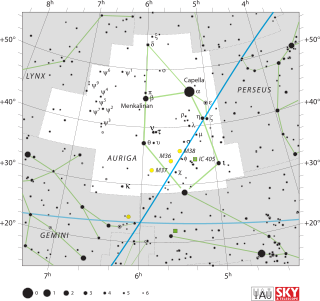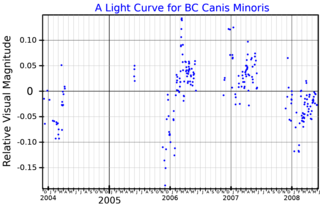
Eta Sculptoris, Latinized from η Sculptoris, is a single, variable star in the central part of the southern constellation of Sculptor. It is visible to the naked eye as a faint, red-hued star with an apparent visual magnitude that fluctuates around 4.81. The star is located approximately 460 light years from the Sun based on parallax, and is drifting further away with a radial velocity of +12 km/s.

ν Virginis, Latinized as Nu Virginis, is a single star in the zodiac constellation of Virgo, located at the western tip of the classic constellation and nearly due south of the prominent star Denebola. It is a red-hued star with an apparent visual magnitude of 4.04 and can be seen with the naked eye. Because the star lies near the ecliptic it is subject to occultations by the Moon. Parallax measurements provide an estimated distance of around 331 light years from the Sun, and it is drifting further away with a radial velocity of +50 km/s.

Pi Aurigae, Latinized from π Aurigae, is the Bayer designation for a single, red-hued star in the northern constellation of Auriga. Located about one degree north of the 2nd magnitude star Beta Aurigae, Pi Aurigae is visible to the naked eye with an apparent visual magnitude of 4.25 Based upon parallax measurements, it is approximately 720 light-years away from Earth. At that distance, the brightness of the star is diminished by 0.54 in magnitude from extinction caused by interstellar gas and dust.

Upsilon Aurigae, Latinised from υ Aurigae, is the Bayer designation for a single star in the northern constellation of Auriga. It has an apparent visual magnitude of 4.74, which means it is bright enough to be seen with the naked eye. Based upon parallax measurements, this star is approximately 500 light-years distant from the Earth. It is drifting further away with a radial velocity of +38 km/s.

54 Arietis is a star in the northern zodiac constellation of Aries. 54 Arietis is the Flamsteed designation. It is a challenge to view with the naked eye even under good viewing conditions, having an apparent visual magnitude of 6.27. Based upon an annual parallax shift of 4.39 mas, it is located approximately 740 light-years distant from Earth, and it is drifting further away with a radial velocity of +44 km/s. The brightness of the star is diminished by 0.15 in magnitude from extinction caused by interstellar gas and dust. The star is positioned near the ecliptic and thus is subject to lunar occultations.

Mu1 Cancri, Latinised from μ1 Cancri, is a variable star in the zodiac constellation of Cancer. The name Mu1 comes from the Bayer naming system: the "1" in the name is because (from Earth) it appears to be close to 10 Cancri, or Mu2 Cancri. It is also known by the variable star designation BL Cancri. The star is dimly visible to the naked eye with an apparent visual magnitude that ranges from 5.87 down to 6.07. Parallax measurements put it about 630 light-years (192 parsecs) from the Sun. At that distance, the visual magnitude is diminished by an extinction factor of 0.28. The position of the star near the ecliptic means it is subject to lunar occultations.

BE Camelopardalis is a solitary variable star in the northern circumpolar constellation of Camelopardalis. It is visible to the naked eye as a faint, red-hued point of light with an apparent visual magnitude that fluctuates around 4.39. The star is located roughly 800 light years away from the Sun based on stellar parallax.

C1 Centauri is a single star in the southern constellation of Centaurus. It has the variable star designation V763 Centauri, while C1 Centauri is the Bayer designation. The star has a red hue and is dimly visibly to the naked eye with an apparent visual magnitude that fluctuates around +5.64. It is located at a distance of approximately 600 light years based on parallax, and has an absolute magnitude of −1.05. It is drifting further away with a radial velocity of +21 km/s. At one time it was a candidate member of the Zeta Herculis Moving Group but has since been excluded.
F Centauri is a suspected astrometric binary star system in the southern constellation of Centaurus. It has a reddish hue and is visible to the naked eye with an apparent visual magnitude that fluctuates around +5.01. The system is located at a distance of approximately 450 light years from the Sun based on parallax, and it has an absolute magnitude of −0.87. O. J. Eggen flagged this star as a member of the Hyades Supercluster.
HD 36678 is single star in the northern constellation of Auriga. This star is dimly visible to the naked eye with an apparent visual magnitude of 5.83. It is located at a distance of approximately 840 light years from the Sun based on parallax.

CQ Camelopardalis, abbreviated as CQ Cam, is a solitary variable star in the northern circumpolar constellation Camelopardalis. It has an apparent magnitude of 5.19, making it visible to the naked eye under ideal conditions. The object is relatively far at a distance of about 2,000 light years but is drifting closer with a heliocentric radial velocity of −22 km/s. It has a peculiar velocity of 21.8+2.1
−1.9 km/s, making it a runaway star.

HD 27245, also known as HR 1335 or rarely 25 H. Camelopardalis is a solitary red-hued star located in the northern circumpolar constellation Camelopardalis. It has an apparent magnitude of 5.4, making it faintly visible to the naked eye. Gaia DR3 Parallax measurements place it approximately 607 light years away from it the Solar System and is drifting further away with a heliocentric radial velocity of 25.2 km/s. At its current distance, HD 27245's brightness is diminished by 0.36 magnitudes due to extinction from interstellar dust. It has an absolute magnitude of −0.27.
17 Camelopardalis is a single star in the northern circumpolar constellation of Camelopardalis, located roughly 960 light years away from the Sun. It is visible to the naked eye as a faint, red-hued star with an apparent visual magnitude of 5.44. This object is moving closer to the Earth with a heliocentric radial velocity of −20 km/s.
HD 56618 is a single star in the southern constellation of Canis Major. It is a red-hued star that is faintly visible to the naked eye with an apparent visual magnitude of 4.66. This object is located at a distance of approximately 390 light years from the Sun based on parallax measurements. It is drifting further away with a radial velocity of +41.5 km/s, having come to within 203 light-years some 2.2 million years ago. Olin J. Eggen listed it as a probable member of the Hyades supercluster.

54 Eridani is a suspected astrometric binary star system located around 400 light years from the Sun in the equatorial constellation of Eridanus. It is visible to the naked eye as a faint, reddish hued star with a baseline apparent visual magnitude of 4.32. The object is moving closer to the Earth with a heliocentric radial velocity of −33 km/s.
98 Herculis is a single star located approximately 590 light years from the Sun in the northern constellation Hercules. It is visible to the naked eye as a dim, red-hued point of light with an apparent visual magnitude of 4.96. The brightness of the star is diminished by an extinction of 0.19 due to interstellar dust. The star is moving closer to the Earth with a heliocentric radial velocity of −19 km/s.

104 Herculis is a solitary variable star located around 560 light years away from the Sun in the northern constellation of Hercules. It has the variable star designation V669 Herculis and the Bayer designation A Herculis, while 104 Herculis is the Flamsteed designation. This object is visible to the naked eye as a dim, red-hued point of light with a baseline apparent visual magnitude of 4.96. It is moving closer to the Earth with a heliocentric radial velocity of −1.2 km/s.

BC Canis Minoris is a variable star in the equatorial constellation of Canis Minor. It has a reddish hue and is just barely visible to the naked eye with an apparent visual magnitude that fluctuates around 6.30. The distance to this object is approximately 520 light years based on parallax, but it is drifting closer with a radial velocity of −67 km/s.

1 Lyncis is a single star in the northern constellation of Lynx. It is also known by its variable star designation of UW Lyncis; 1 Lyncis is the Flamsteed designation. This object is visible to the naked eye as a faint, reddish-hued star with an apparent visual magnitude of 4.95. It is moving further from the Earth with a heliocentric radial velocity of 12 km/s.

8 Leonis Minoris is a solitary, red hued star located in the northern constellation Leo Minor. It has an apparent magnitude 5.37, making it faintly visible to the naked eye. Based on parallax measurements from the Gaia satellite, the object is estimated to be 492 light years distant. It is receding with a heliocentric radial velocity of 40 km/s. At its current distance, 8 LMi is diminshed by 0.12 magnitudes due to interstellar dust.















